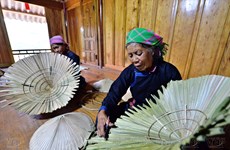Sa Pa tour guides face both sweat and joy
If you see little girls wandering through the Sa Pa market with brocade
bags and jungle knives, they are probably tour guides.
If you see little girls wandering through the Sa Pa market with brocade
bags and jungle knives, they are probably tour guides.
Dozens of ethnic Mong girls show tourists around the resort town and the surrounding villages. While the children have not been professionally trained, growing up in the northern province of Lao Cai made them more familiar with the area than any professional.
When they were very young, they became acquainted with the winding roads leading to their villages. Even learning English is not very complicated for them, as their youth enables them to quickly imitate speaking patterns and the Mong language, like English, is a "spirant language" - a feature that a linguist told us helps local children learn to speak English very fast with accurate pronunciation.
Originally, there were not many job requirements. With good health, a vivacious personality and a few words of English, the girls could easily go down to the market and find foreign visitors to guide around the area.
But the demands of foreign tourists are becoming quite complicated. Brief tours of Cat Cat village, Cau May (Cloud Bridge), Ham Rong mountain and Ta Phin village are no longer wanted. Tourists now prefer weeklong tours of more isolated villages.
"We must spend weeks with tourists, helping them pass streams and mountains, even helping carry their luggage," said Hang A Sinh, a tour guide in Xin Chai village. "Cooking for Western guests is very complicated. If they think food is unhygienic, they stop eating. If they eat something and get sick, we also suffer as they might cut our pay."
Undertaking these tours requires careful calculation: how many people in the group, how many stops during the trip, how many meals a day, how to prepare firewood, fire, pots and food.
"The job is so tough," Sinh said.
He recounted the story of an Australian student who wanted to visit San Sa Ho for a week: "She was beautiful, much taller than I am, and very curious about food.
The way to San Sa Ho in those days was desolate and hard to walk. Along the way, apart from taking notes and talking with the locals, if she saw something edible, she would require me to let her try it. When the tour was almost over, suddenly she felt sick.
"I didn't know what to do. Then I remembered that I had a friend living nearby. As my client could not walk, I had to carry her on my back. My shirt was so wet with sweat! By the afternoon, I managed to bring her to my friend's house.
"My friend's family helped me treat my client. The next morning, she recovered and managed to come back to Sa Pa with me."
For that trip, she paid 500 USD as an indication of her gratefulness to Sinh, who was then sick for three days.
Before leaving Sa Pa, she asked Sinh for his address and regularly sent mail and gifts to him. Last year, when she returned with her husband, they met Sinh and retold the story of their eventful trip. "Her husband was joyful and he invited me to visit them in Australia one day!"
Thao Thi Ru, who joined the industry at the age of 15, is also famous in Sa Pa for leading visitors on adventurous tours. Perhaps her most noteworthy achievement is taking tourists up Mount Fansipan.
If the client is healthy, she can finish the tour within three days. While the price is high, she says it reflects her many worries about assuring safety for clients.
"If we undertake these tours, we must show them where to purchase strings and sleeping bags, take care of their meals along the way and make sure they stay healthy," she said.
Tour guides must also learn folk remedies to heal flu, pain, dislocation and sometimes even snake bites in case clients suffer from these ailments along the trip.
"To earn money from this job, particularly from Western guests, is not simple. If we satisfy their demands, understand their psychology and create excitement for them, apart from the bonus, we are also invited for meals, but otherwise we get only our payment," she said.
Though these tour guides earn quite high incomes and know how to care for their health, they are all thin like reeds. Perhaps hours leading clients and worrying about the job have drained their strength?
Vice Chairwoman of Lao Cai province People's Committee Ha Thi Nga said local authorities are currently focusing on tourism development.
"Currently, Sa Pa district has about 80 ethnic Mong and Red Dao tour guides. They live in their native villages and do not formally study English.
"These people should be fully equipped with knowledge so they can better introduce cultural values and local traditions and make guided tours more professional."
To protect their tourism reputation, Sa Pa district has implemented a project "Building a civilized lifestyle in commercial and tourism activities" that will last until 2015. The authorities set up places for vendors to stop them from following tourists.
The initial results have created positive changes. There are fewer scenes of ethnic minority women and children clinging to tourists for hours, making visitors feel uncomfortable.
Lo Su May, 29, a Dao woman from Ta Chai hamlet of Ta Phin Commune, used to work as a street vendor in Sa Pa. It took her five hours to walk to town from her house.
"Since the district implemented the project and educated us about making Sa Pa's image more civilised, I decided to stay and sell brocade products at my commune's sale place," she said.
Sa Pa district's Vice Chairman Nguyen Ngoc Hinh said the project would also ensure higher incomes for local residents.
To that end, the district will held training classes for residents in tourism, sales and marketing skills.
"English classes are being held for ethnic people so they can better serve tourists," he said.
Deputy Director of the provincial Department of Culture, Sports and Tourism Nguyen Dinh Dung said that the project was a step in the right direction for Sa Pa's tourism industry: "I believe the reputation of Sa Pa tourism will be elevated."-VNA
Dozens of ethnic Mong girls show tourists around the resort town and the surrounding villages. While the children have not been professionally trained, growing up in the northern province of Lao Cai made them more familiar with the area than any professional.
When they were very young, they became acquainted with the winding roads leading to their villages. Even learning English is not very complicated for them, as their youth enables them to quickly imitate speaking patterns and the Mong language, like English, is a "spirant language" - a feature that a linguist told us helps local children learn to speak English very fast with accurate pronunciation.
Originally, there were not many job requirements. With good health, a vivacious personality and a few words of English, the girls could easily go down to the market and find foreign visitors to guide around the area.
But the demands of foreign tourists are becoming quite complicated. Brief tours of Cat Cat village, Cau May (Cloud Bridge), Ham Rong mountain and Ta Phin village are no longer wanted. Tourists now prefer weeklong tours of more isolated villages.
"We must spend weeks with tourists, helping them pass streams and mountains, even helping carry their luggage," said Hang A Sinh, a tour guide in Xin Chai village. "Cooking for Western guests is very complicated. If they think food is unhygienic, they stop eating. If they eat something and get sick, we also suffer as they might cut our pay."
Undertaking these tours requires careful calculation: how many people in the group, how many stops during the trip, how many meals a day, how to prepare firewood, fire, pots and food.
"The job is so tough," Sinh said.
He recounted the story of an Australian student who wanted to visit San Sa Ho for a week: "She was beautiful, much taller than I am, and very curious about food.
The way to San Sa Ho in those days was desolate and hard to walk. Along the way, apart from taking notes and talking with the locals, if she saw something edible, she would require me to let her try it. When the tour was almost over, suddenly she felt sick.
"I didn't know what to do. Then I remembered that I had a friend living nearby. As my client could not walk, I had to carry her on my back. My shirt was so wet with sweat! By the afternoon, I managed to bring her to my friend's house.
"My friend's family helped me treat my client. The next morning, she recovered and managed to come back to Sa Pa with me."
For that trip, she paid 500 USD as an indication of her gratefulness to Sinh, who was then sick for three days.
Before leaving Sa Pa, she asked Sinh for his address and regularly sent mail and gifts to him. Last year, when she returned with her husband, they met Sinh and retold the story of their eventful trip. "Her husband was joyful and he invited me to visit them in Australia one day!"
Thao Thi Ru, who joined the industry at the age of 15, is also famous in Sa Pa for leading visitors on adventurous tours. Perhaps her most noteworthy achievement is taking tourists up Mount Fansipan.
If the client is healthy, she can finish the tour within three days. While the price is high, she says it reflects her many worries about assuring safety for clients.
"If we undertake these tours, we must show them where to purchase strings and sleeping bags, take care of their meals along the way and make sure they stay healthy," she said.
Tour guides must also learn folk remedies to heal flu, pain, dislocation and sometimes even snake bites in case clients suffer from these ailments along the trip.
"To earn money from this job, particularly from Western guests, is not simple. If we satisfy their demands, understand their psychology and create excitement for them, apart from the bonus, we are also invited for meals, but otherwise we get only our payment," she said.
Though these tour guides earn quite high incomes and know how to care for their health, they are all thin like reeds. Perhaps hours leading clients and worrying about the job have drained their strength?
Vice Chairwoman of Lao Cai province People's Committee Ha Thi Nga said local authorities are currently focusing on tourism development.
"Currently, Sa Pa district has about 80 ethnic Mong and Red Dao tour guides. They live in their native villages and do not formally study English.
"These people should be fully equipped with knowledge so they can better introduce cultural values and local traditions and make guided tours more professional."
To protect their tourism reputation, Sa Pa district has implemented a project "Building a civilized lifestyle in commercial and tourism activities" that will last until 2015. The authorities set up places for vendors to stop them from following tourists.
The initial results have created positive changes. There are fewer scenes of ethnic minority women and children clinging to tourists for hours, making visitors feel uncomfortable.
Lo Su May, 29, a Dao woman from Ta Chai hamlet of Ta Phin Commune, used to work as a street vendor in Sa Pa. It took her five hours to walk to town from her house.
"Since the district implemented the project and educated us about making Sa Pa's image more civilised, I decided to stay and sell brocade products at my commune's sale place," she said.
Sa Pa district's Vice Chairman Nguyen Ngoc Hinh said the project would also ensure higher incomes for local residents.
To that end, the district will held training classes for residents in tourism, sales and marketing skills.
"English classes are being held for ethnic people so they can better serve tourists," he said.
Deputy Director of the provincial Department of Culture, Sports and Tourism Nguyen Dinh Dung said that the project was a step in the right direction for Sa Pa's tourism industry: "I believe the reputation of Sa Pa tourism will be elevated."-VNA












